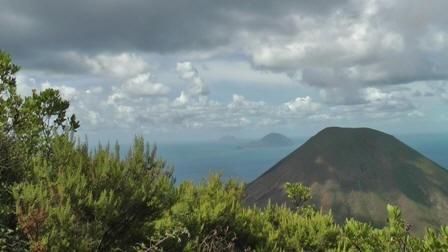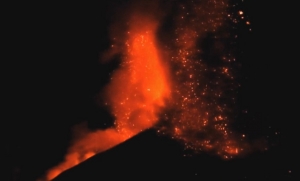Active volcanism is experienced all over the globe. Millions of people live in a close vicinity of active volcanoes that pose a real threat to human lives. Understanding the processes leading to eruptions, hazard assessment, mitigation, and early warning leading to evacuation of inhabitants are vital. The precursors to an eruption are very complex and depend on many conditions that may be respective to the given region or the given volcano. The study of temporal gravity changes and vertical displacements of the surface plays an important role in getting to know the volcanic processes associated with a given volcano.
 Our department has participated in developing and applying the methods for interpreting observed gravity changes and surface deformations. We were involved in modelling using point sources of heat and pressure to understand the changes linked with magma processes inside a volcano. Also the TFM methodology was tested for its potential in interpreting gravity changes. Case studies were performed for two volcanoes, Mayon in Philippines and Merapi in Indonesia. This research was carried out within international cooperation with Dr. Fernández of the Institute of Astronomy and Geodesy, CSIC-UCM, Madrid, Spain, and Dr. Jentzsch and colleagues of the Institute of Geosciences, FSU Jena, Germany. Gravity changes must be measured very accurately using precise gravimetric procedures. In addition vertical displacement of gravity points, coming from precise GPS measurements, must be observed.
Our department has participated in developing and applying the methods for interpreting observed gravity changes and surface deformations. We were involved in modelling using point sources of heat and pressure to understand the changes linked with magma processes inside a volcano. Also the TFM methodology was tested for its potential in interpreting gravity changes. Case studies were performed for two volcanoes, Mayon in Philippines and Merapi in Indonesia. This research was carried out within international cooperation with Dr. Fernández of the Institute of Astronomy and Geodesy, CSIC-UCM, Madrid, Spain, and Dr. Jentzsch and colleagues of the Institute of Geosciences, FSU Jena, Germany. Gravity changes must be measured very accurately using precise gravimetric procedures. In addition vertical displacement of gravity points, coming from precise GPS measurements, must be observed.
 More recently we have introduced, in cooperation with Dr. Prutkin of the Jena University, Germany, a novice and flexible methodology for interpreting the temporal gravity changes consisting of the following steps: (1) removal of regional trend by a 2D harmonic function that matches on the boundary of the study area the observed gravity changes, (2) depth-wise decomposition of signal (the residual gravity changes) of vertically distributed multiple sources, (3) identification of source locations, orientations, sizes, and strengths by means of approximation of sources by 3D line segments, (4) determination of sources in terms of star-convex homogenous bodies by a non-linear inversion based on the method of local corrections.
More recently we have introduced, in cooperation with Dr. Prutkin of the Jena University, Germany, a novice and flexible methodology for interpreting the temporal gravity changes consisting of the following steps: (1) removal of regional trend by a 2D harmonic function that matches on the boundary of the study area the observed gravity changes, (2) depth-wise decomposition of signal (the residual gravity changes) of vertically distributed multiple sources, (3) identification of source locations, orientations, sizes, and strengths by means of approximation of sources by 3D line segments, (4) determination of sources in terms of star-convex homogenous bodies by a non-linear inversion based on the method of local corrections.
Participation in international workshops
To cooperate on this topic with geophysicists and volcanologists internationally we took part in the following meetings:
 2013 workshop 15th annual conference of IAMG: Frontiers of Mathematical Geosciences: New approaches to understand the natural world, 2–6 Sept., 2013, Madrid, Spain
2013 workshop 15th annual conference of IAMG: Frontiers of Mathematical Geosciences: New approaches to understand the natural world, 2–6 Sept., 2013, Madrid, Spain
2011 workshop „SOS“ Seismic and Other Signals, ESC-2011, Salina, Aeolian Islands, Italy 2003, 2005, 2009 workshops on Lanzarote, Canary Islands "Time-variable deformation and gravity fields: theory, observations, and modelling." Casa de los Volcanes, Lanzarote, Canary Islands, Spain
References
- Peter Vajda, Ilya Prutkin, Jo Gottsmann, 2013. Reinterpretation of Teide 2004–2005 gravity changes by 3D line segments approximation (oral, invited talk). 15th annual conference of IAMG: Frontiers of Mathematical Geosciences: New approaches to understand the natural world, 2–6 Sept., 2013, Madrid, Spain
- Prutkin I., Vajda P. (2011) On interpreting temporal gravity changes at volcanoes by 3D inversion based on the method of local corrections. Annual workshop 2011 of the Working Group “Volcano Seismology” of the European Seismological Commission: “S.O.S.: Seismic and Other Signals”, September 17–24, 2011, Salina, Aeolian Islands, Italy (oral presentation)
- Vajda P., L. Brimich, G. Jentzsch, T. Jahr, A. Weise, 2004. "Towards interpreting gravity changes by means of the Truncation Filtering Methodology: Mayon volcano, Philippines, case study." Contr. Geophys. Geod. 34(1): 1–19
- Vajda P. and L. Brimich, 2002. "Analytical derivation of the instant of the dimple pattern onset in 2D truncation filtering methodology for a point source of heat geodynamic model." Contr. Geophys. Geod. 32(1): 41–47
- Brimich L., M. Hvoždara, and P. Vajda, 2002. "Temporal gravity variations due to the model geodynamic event driven by a point source of heat." Contr. Geophys. Geod. 32(1): 49–55
- Vajda, P., Brimich, L., Jentzsch, G., Jahr, T., and Weise, A. "Interpreting temporal changes of gravity at Mayon using the TFM: preliminary results." Workshop "Time-variable deformation and gravity fields: theory, observations, and modelling." Casa de los Volcanes, Lanzarote, Canary Islands, Spain, February 18–21, 2003, (oral presentation)
- Vajda, P., 2003. "Interpreting the temporal changes of gravity by means of the truncation filtering methodology (TFM)." Workshop "Time-variable deformation and gravity fields: theory, observations, and modelling." Casa de los Volcanes, Lanzarote, Canary Islands, Spain, February 18–21, 2003, (oral presentation)
- Vajda, P., Brimich, L., Jentzsch, G., Jahr, T., and Weise, A. Interpreting temporal changes of gravity using the TFM: Mayon volcano case study. 1st Workshop on International Gravity Field Research, Graz, Austria, May 8–9, 2003, (oral presentation)
- Vajda P., and L. Brimich, 2001. "Geodynamic applications of the truncation filtering methodology: A synthetic case study for a point source of force representing the upward pressure around a magmatic body" Contr. Geophys. Geod., 31(4): 683–693, Correction Contr. Geophys. Geod. 32(2): 195–196
- Vajda P., L. Brimich, and P. Vaníček, 2000. "Geodynamic applications of the truncation filtering methodology: A synthetic case study for a point source of heat: Progress report." Contr. Geophys. Geod. 30(4): 311–322
- Vajda, P., Brimich, L. "Analytical derivation of the of the instant of the dimple pattern in 2D-truncation filtering methodology for a point source of heat geodynamic model." EGS-AGU-EUG Joint Assembly, Nice, France, April 6–11, 2003,(poster)

